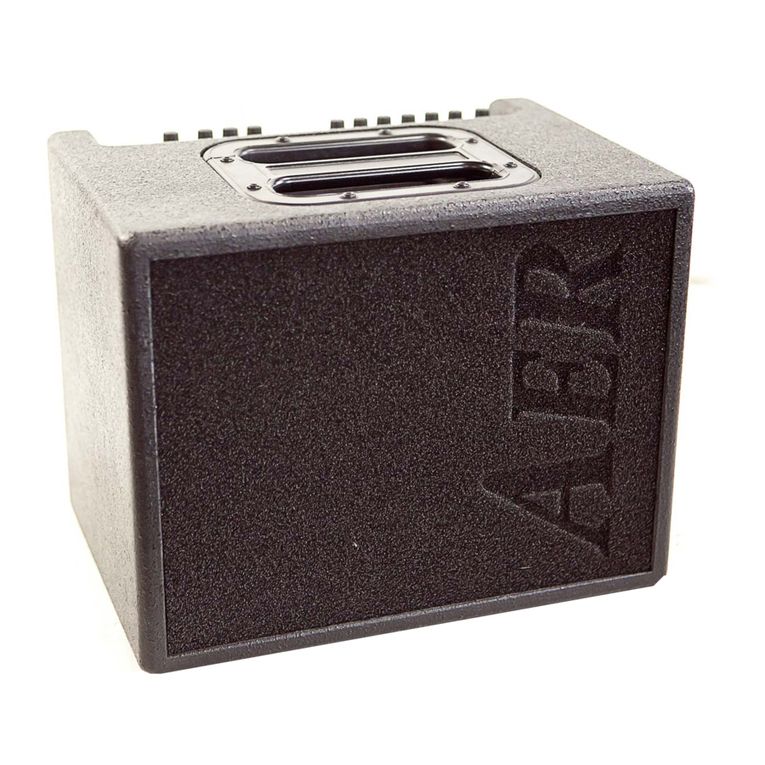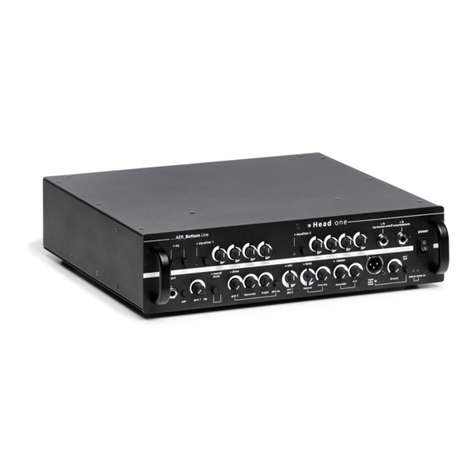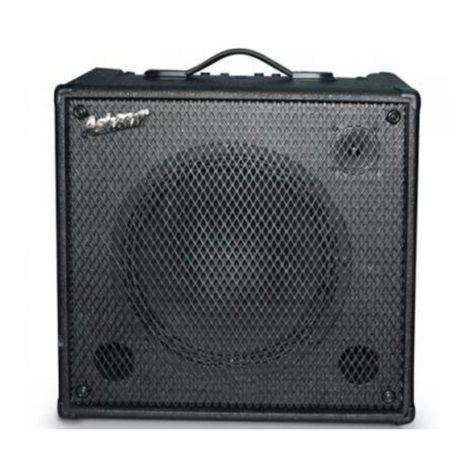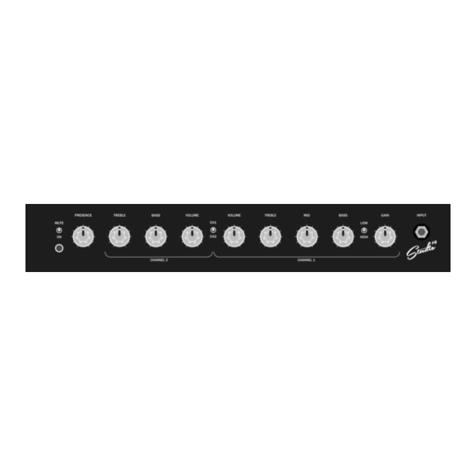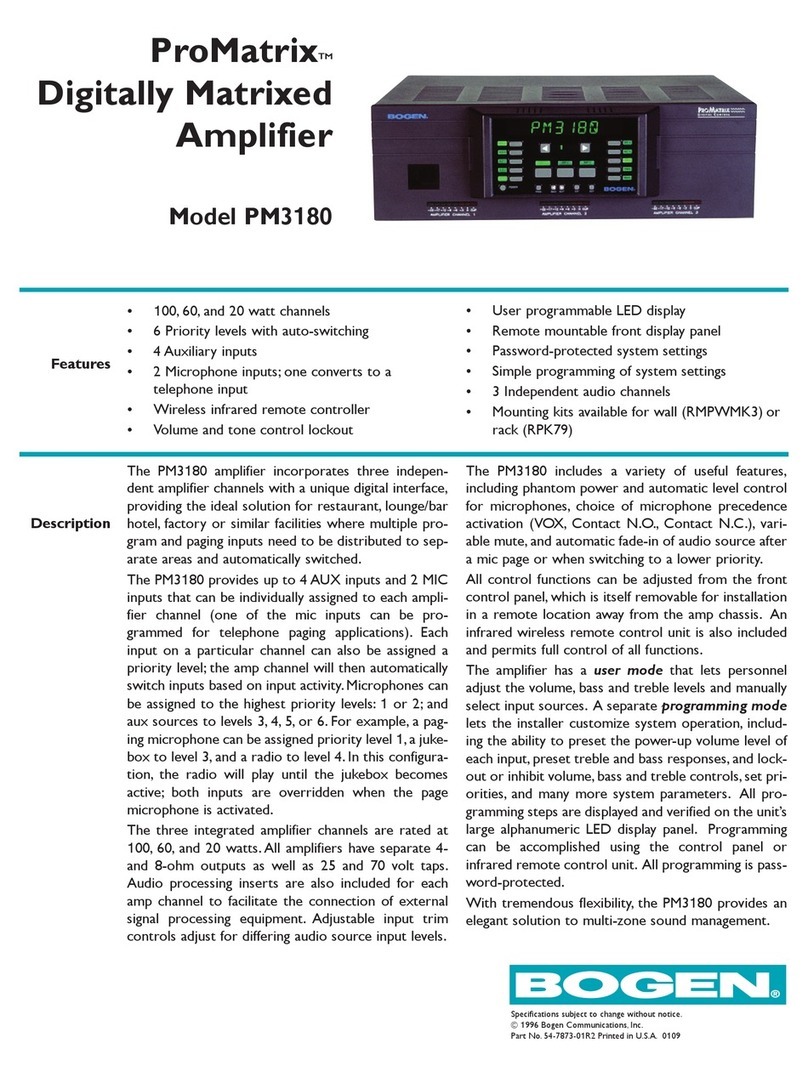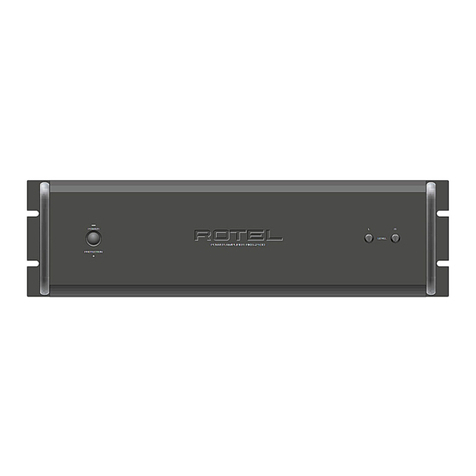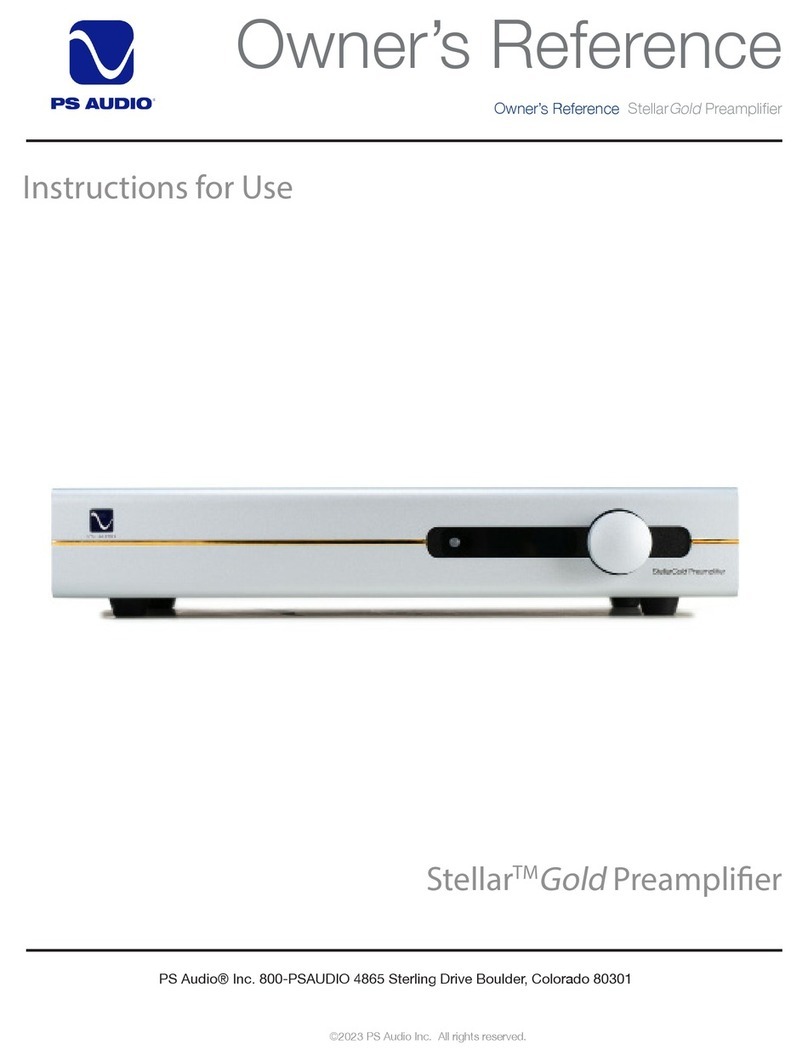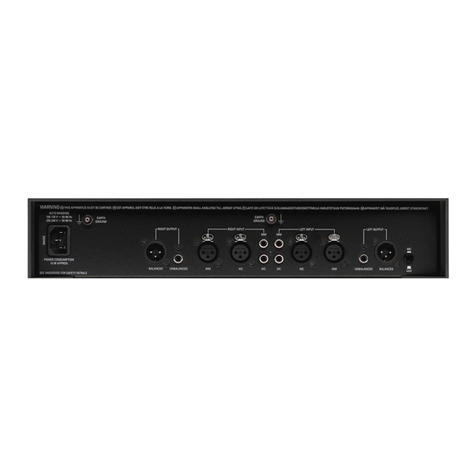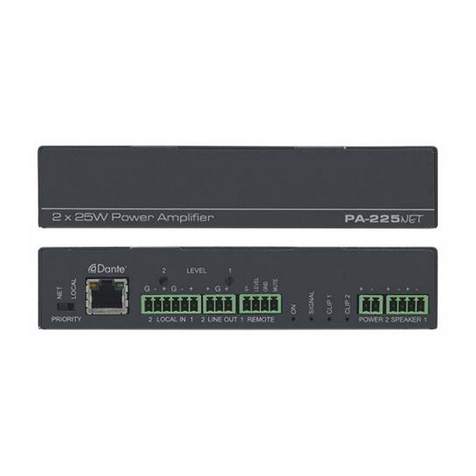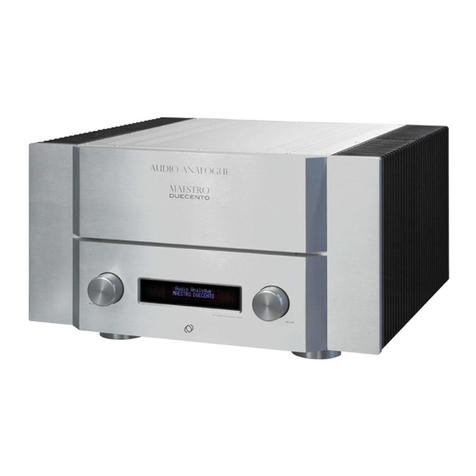AER Compact Mobile2 User manual

1
Compact Mobile2
user manual
2012:
The Look has changed!
Register your
Compact Mobile
2
:
www.aer-amps.com
> Customer Service

2
Compact Mobile2
user manual
Contents Page
1. Introduction 3
2. Safety Instructions 4
3. Controls and connections 5
3.1 Front side 5
3.2 Rear side 6
4. Starting up 7
4.1 Cabling and switching-on 7
4.2 Level adjustment 7
5. Functional characteristics 7
5.1 Equalization 7
5.2 Eects 8
5.3 Footswitch 8
5.4 Phantom powering 8
5.5 Battery operation and care 9
6. Technical specicatios 10
7. Circuit diagram 12

3
1. Einleitung
Welcome to B!
Thank you for purchasing the Compact Mobile2.
The Compact Mobile2is a professional, compact
and powerful amplier, specially designed for the
amplication of acoustic instruments, but equally
suitable for electric instruments and voice, further-
more you can add a playback-signal to your perfor-
mance. The internal battery allows you to operate
your Compact Mobile2up to 4 hours without con-
necting the amp to the mains.
All AER-systems are subtly dynamically controlled
which ensures absolute reliability in full load opera-
tion despite strikingly small sizes and little weight.
Read on and have fun using your Compact Mobile2!

4
2. Safety instructions
The following guidelines shall help minimize the risk
of injury through re or electric shock.
1. Carefully read these safety notes before you use
the device!
2. Keep these safety notes in a safe place.
3. Pay attention to all warnings, instructions and ad-
ditional texts on the unit.
4. Do not install or use your device in close proximity
to water or if you are wet yourself.
5. Use your device in a safe place where nobody can
step on cables or trip over and damage them.
6. Always pull the mains plug before cleaning your
device. Use only a dry cloth for cleaning. Avoid the
use of detergents and do not let any liquids seep
into the unit.
7. Never install your device close to units with strong
electromagnetic elds such as large mains transfor-
mers, revolving machines, neon illumination etc. Do
not lay signal cables parallel to power current cables.
8. There are no user-serviceable components inside
the unit. To avoid the risk of an electric shock, the
unit must not be opened. All maintenance, adjust-
ment and repair works should be carried out by
qualied sta only. Any unauthorized tampering will
void the 2-year warranty.
9. In keeping with the EMV regulations screened
cables with correctly tted connectors must be used
for all signal connections.
10. Always use an earthed power supply with the
correct mains voltage. If you are in doubt about the
power outlets ground, have it checked by a qualied
technician.
11. Cable up your device only when it is powered o.

5
channels 1 + 2
efx
mains & master
mains & masterbattery control
3.1 Front side
1) input (ch. 1) signal input, socket for 6,3 mm mono jackplug
2) high/low input sensitivity switch, attenuator = o = on
3) clip overload indicator
4) gain input level control
5) colour tone colour lter activation switch = not active = active
6) bass bass frequency level control
7) middle middle frequency level control
8) treble treble frequency level control
9) input (ch. 2) signal input, combo-socket for 6,3 mm mono jackplug and
XLR-connectors
10) line/mic signal source selector switch:
= line (only via jackplug) for instruments (pickup) and other line level sources
= mic (only via XLR-connector) for microphones
11) pan eect signal distribution control
12) select eect select switch
13) level level control internal eect
14) power on/o status indicator
15) master master level control
16) low battery battery status indicator
17) charge battery charge indicator
18) phantom
power 48V 48V phantom power switch for microphone = o = on
19) aux level aux-signal level control
3. Controls and connections
IB_CPM_120718
clip clip power
gain gain bass treble pan select level master
aux level
colour bass middle treble
high
low
line
mic
off
on
channel 1 channel 2
input input
efx
phantom
power 48V
chargelow
battery
Compact Mobile2
battery-powered acoustic amplifier
12
3 3
4 4
56 67 8 8
9
10 11 12 13
14
15
1817
16
19

6
Compact Mobile2
battery-powered acoustic amplifier
aux in headphones
power on
line
out
return
send
footswitch DI-out
tuner
L
R
tip
= int. efx
ring = ext. efx
on/off
1 = gnd
2 = pos
3 = neg
DC12V DC only
on/off1= – / 2= +
C A U T I O N
RISK OF ELECTRIC SHOCK
DO NOT OPEN
AT T E N T I O N
RISQUE DE CHOC ELECTRIQUE
NE PAS OUVRIR
IF_CPM_120718
1 2
3
4
5 7
8
Compact Mobile2
battery-powered acoustic amplifier
aux in headphones
power on
line
out
return
send
footswitch DI-out
tuner
L
R
tip
= int. efx
ring = ext. efx
on/off
1 = gnd
2 = pos
3 = neg
DC12V DC only
on/off1= – / 2= +
C A U T I O N
RISK OF ELECTRIC SHOCK
DO NOT OPEN
AT T E N T I O N
RISQUE DE CHOC ELECTRIQUE
NE PAS OUVRIR
IF_CPM_120718
9 10 11
6
3.2 Rear side
1) aux in: stereo input for additional signal sources,
e.g. CD-player, Cinch/RCA-sockets (white = left chan-
nel, red = right channel)
2) line out: The line out supplies a pre-amp signal
taken after tone-control, eects and master for for-
warding to other appliances.
3) headphones: This output enables you to connect
stereo headphones and mutes the loudspeaker.
!!!
Warning: Only use headphones
with stereo jackplugs in this output
socket!!!
4) send: Send is an output to connect to an external
eect device and in conjunction with return (input)
forms a loop here designed as external eect loop.
The eect can be switched on or o via footswitch.
5) return: Return as part of the eect loop operates
as signal input from an external eect device (from
output of the eect device). The eect can be swit-
ched on or o via footswitch. Return on its own can
also be used as quasi auxiliary signal input (-10
dbV).
6) tuner: The tuner output supplies a pre-master
signal (-9 dbV) to connect an external tuner to the
Compact Mobile2.
7) footswitch: Connection socket for a double-
footswitch (on-/o-switch, tip = internal eect/ring
= external eect on/o).
8) DI-out: Preamp-output with symmetrical signal,
after tone-control, pre master, without eects.
9) 12V DC only: Connection socket for an optional
12V-cable to an external battery.
10) DC on/o: On/o-switch for the connection so-
cket (9).
11) power on: Combined mains switch with mains
socket and fuse holder.
IF_CPM_120718

7
4. Starting up
4.1 Cabling and switching on
Before connecting to mains, please ensure that your
local mains voltage is suitable for the voltage of the
device (e.g. 120V in the USA, 230V in Europe). The
relevant specs and sa-
fety symbols are printed
on the rear side of the
unit.
Connect all cables ac-
cording to your application and switch the amplier
on. The green power control LED indicates operati-
onal readiness.
4.2 Level adjustment
First ensure, that the master level control is zeroed
(over to far left), so that when you are setting the
sound level, the signal passes through the elect-
ronics only and does not reach the loudspeaker.
By pressing the high-/low- (attn.) resp. line-/mic-
switches you can adapt the amplier to your signal
sources (guitar pickups, microphone etc).
Turn the gain control clockwise until the red clip
indicator ashes momentarily when playing with a
strong attack. Thus you make sure that your signal
source (e.g. instrument) provides the input-stage of
the amplier with the necessary input.
Note: Level adjustment
By setting the level correctly we mean the signal le-
vel in one or several devices in a signal chain is neit-
her too high nor too low. This applies equally to all
circuits in a complete circuit design (EQs, preamps
etc.)
Consequently, care must be taken that no part of the
circuit is overloaded or that distortion is unintentio-
nally added to the signal.
We have carefully designed the circuit to achieve this
objective whilst also providing controls for„manual“
intervention.
channel 1
IF_Compact603_20120529
Compact 603
channel 2
IF_Compact603_20120529
Compact 603
The clip-LED indicates an overload. A short icker
is of no danger to AER devices. During operation a
short icker can be accepted, to be on the safe side
you should reduce the gain slightly to achieve an
optimal and distortion-free performance.
Finally set the desired overall volume level with the
master level control.
5. Functional characteristics
5.1 Equalization
The triple-/dual-band equalizer of your Com-
pactMobile2provides you with an active and high
quality sound interaction tool that supports the na-
tural tone of instruments and voice whilst simulta-
neously oering you the possibility of a controlled
accentuation.
With all controls in mid position the lters are set
to produce a very pleasing and natural sound im-
pression that you can „colour up“ by using the co-
lour lter with the eect of lowering the mids and
lifting the trebles. The tone becomes more open
and light and is especially suited for ngerpicking
techniques.
The equalization can support or soften the eect of
the colour lter and allows a dierentiated mids-
accentuation.
Note:
The active equalization of the CompactMobile2
eects the signal adjustment. If you spot an inten-
sied ickering of the clip indicator, level the sig-
nal level with the gain control (s. 4.2 Level adjust-
ment).
colour bass middle treble
A: with colour-lter (switch pressed)
reduce treble to soften possible sharpness
colour bass middle treble
B: without colour-lter (switch not pressed)
boost treble to brighten the sound

8
5.3 Footswitch
A standard double-footswitch (on-/o-switch)
can be plugged into the footswitch-socket on the
rear side of the amplier via stereo cable. By this
footswitch the internal and external eects can be
switched on and o.
5.4 Phantom power
Microphones requiring 48V phantom power can be
connected to the XLR-socket of channel 2 directly.
Factory-provided phantom power is activated but,
if required, may be deactivated by an internal jum-
per.
In contrary 9V phantom power, if required, can ad-
ditionally be activated in channel 1 by an internal
jumper.
Please note: For both alterations the device must
be opened, therefore only qualied service per-
sonnel may carry out the modications concer-
ning the de-/activating of phantom power.
General Note: Use of 48V or 24V phantom power
(Phantom power = remote supply, here: powering
an audio device via the connected audio line)
Turn on the phantom power only if the unit connec-
ted to an XLR socket that is designed to handle it!
In general, suitable units are e.g. condenser micro-
phones, active DI-boxes and other special audio
devices, whose power supply is drawn from the
phantom power. Such devices are also labelled ac-
cordingly; please heed the permissible power con-
sumption (max.10mA).
High-quality dynamic microphones with a balanced
signal need no phantom power, but can handle it
anyway.
Other devices, which have not been designed expli-
citly for phantom power operation, can suer from
considerable malfunctions and damage may result
as well.
Examples of devices that may be damaged by in-
correct application of phantom power include:
Low-cost dynamic microphones with a mono jack-
plug (unbalanced signal) that were tted afterwards
with an XLR connector.
Audio devices with a balanced XLR output (e.g. DI-
boxes, eects devices, instrument preamps with
a DI output etc.) which are not protected against
phantom power applied to their XLR output. (The
DI connectors on AER products are protected
against applied phantom power.)
Other audio devices (such as preamps, eects pe-
dals etc.) whose unbalanced line output was repla-
ced by an XLR socket.
If in doubt please consult the manufacturer of the
device you are using.
5.2 Eects
The CompactMobile2has a built-in (internal) digi-
tal eects processor, with the select-switch you can
choose between 4 dierent eects:
1 = reverb 1 (short)
2 = reverb 2 (long)
3 = delay (320 ms)
4 = chorus
The efx-level-control determines the intensity of
the internal eects (left stop = no eect).
Furthermore an additional eects unit (external ef-
fect) may be connected to the CompactMobile2.
For this purpose use the send and return sockets
on the rear side of the amplier (send goes to in-
put, return to the output of the external eects
device). The intensity of the eect is adjusted at the
external eects unit.
With the efx-pan control the dierent eects are
blended with the original signal. The efx-pan works
as follows:
left stop: internal eect on channel 1
external eect on channel 2
mid position: internal eects on channel 1 + 2
external eects on channel 1 + 2
right stop: internal eects on channel 2
external eects on channel 1
P.S. For questions or suggestions contact us:

9
5.5 Battery operation and care
The battery in your CompactMobile2is a high-end
leakproof and maintenance-free lead-gel-battery.
It‘s high capacity will be available for a long time if
you follow some precautionary measures.
1. Charging
To charge the battery, plug your AER CompactMo-
bile2to the mains and switch it on. If you do not
want to use the amplier during the charging pro-
cess, turn gain- and master-control to minimum vo-
lume (as far left as possible).
The charging of the batteries will be indicated by
the yellow charge-LED. The battery is fully charged
when the charge-LED is o. Charging time depends
on various factors and can vary according to the
battery’s charging state at the beginning of the pro-
cess.
A partly discharged battery will be charged comple-
tely after a few hours whereas the charging process
of a completely discharged battery can last more
than 24 hours. The average charging-time of a con-
tinually discharged battery will take about 8 to 14
hours. By constantly controlling the battery’s vol-
tage, the intelligent charge control electronics pre-
vents the battery from overcharge.
2. Operation
A completely charged battery allows 2 to 4 hours of
playing independent of mains supply, depending
on volume and dynamics. Low volume will enable
you to play up to 8 hours. The low-battery-LED indi-
cates that the battery is almost empty.
As soon as the minimal allowed battery voltage has
been reached, the charge control electronics will
automatically switch the AER CompactMobile2o,
in order to avoid deep-discharge. After the amplier
has been switched o by the charge control elect-
ronics it can only be operated when connected to
the mains. A discharged battery should be charged
as soon as possible. Storage in discharged condition
may damage the battery.
3. Storage and self-discharge
If your AER CompactMobile2is stored or not used
over a long period, the battery should be fully char-
ged in order to keep it‘s capacity. Being switched o
for a long time with discharged battery may damage
the battery irreparably by natural self-discharge.
During normal use, the charge control electronics
can protect the battery from deep-discharge, but
it cannot prevent the electronical process of self-
discharge in the battery itself.
Always store your AER CompactMobile2with char-
ged battery. A fully charged lead-gel-battery will
still be 60% charged after one year of storage whilst
a discharged battery might be damaged even after
a few weeks.
4. Temperature Dependency
Please note that the battery’s capacity (and thus
playing time) depends on the surrounding tempe-
rature. Playing outside in winter will reduce playing
time by 20 to 30% compared to playing in heated
rooms or outside in summer. This is a normal reac-
tion and not a sign of a defective battery.
5. Battery Life Expectancy
The producer of the batteries used in the AER Com-
pactMobile2declares a life period of approximately
5 years at intended use.
6. Warranty
Batteries are items that wear out through the or-
dinary course of use, thus they are excluded from
statuary two-year liability. If a defect has not been
caused by AER manufacture, warranty will expire af-
ter 6 months.
7. Battery Exchange
The exchange of worn out batteries should be car-
ried out by a specialist or by AER Service as both
amplier and new battery could be severely dama-
ged through improper connecting or assembly. Im-
proper connection may cause explosion or electric
shock.
PB

10
6. Technical specications Compact Mobile2 – page 1
www.aer-amps.com
CompactMobile2- 2012_07_GB
Technical data
Inputs
High impedance, unbalanced instrument or
line input
Mono jack socket, ¼“ (6.35 mm)
Min. input voltage: 22 mV (–33 dBV)
Max. input voltage: 5 V (+14 dBV)
Input impedance: 2.2 M|| 350 pF
Equivalent input noise voltage (A-weighted):
1.5 μV (– 117 dBV)
High/low (attenuator) switch: –10 dB
Phantom power: Optional (see notes), 9 V
DC / max. 100 mA, on ring of input jack,
short circuit protected
channel 1
clip indicator
Headroom: min. 6 dB
Switchable line / microphone input
Combo socket, XLR + jack ¼” (6.35 mm)
line mode (via jack input only)
High impedance, unbalanced instrument or
line input
Min. input voltage: 27 mV (–31 dBV)
Max. input voltage: 7 V (+17 dBV)
Input impedance: 2.2 M|| 350 pF
Equivalent input noise voltage (A-weighted):
2.4 μV (– 113 dBV)
mic mode
Microphone input, XLR (balanced), stereo
jack (balanced), or mono jack (unbalanced)
1 / sleeve = ground,
2 / tip = positive (+),
3 / ring = negative (–)
Min. input voltage: 3.3 mV (–50 dBV)
with low-gain option: 5.8 mV (–45 dBV)
Max. input voltage: 1 V (0 dBV)
with low-gain option: 1.8 V (+5 dBV)
(see notes)
Input impedance (balanced): 1.2 k
Input impedance (unbalanced): 2.7 k
Voice filter:
–10 dB at 270 Hz referred to 10 kHz
Equivalent input noise voltage (A-weighted):
0.9 μV (–121 dBV)
Phantom power: XLR only, 48 V, switchable,
R = 6.8 kper terminal, max. 10 mA total,
short-circuit protected
channel 2
clip indicator
Headroom: min. 6 dB
aux in Auxiliary stereo input, e.g. for CD player
Cinch (RCA) sockets, L / R
Level adjustable by aux level
Min. input voltage: 100 mV (–20 dBV)
Max. input voltage: 3.5 V (+11 dBV)
Input impedance: 22 k
return Input from external parallel effect loop, or
supplementary input
Mono jack, ¼” (6.35 mm)
Min. input voltage: 320 mV (–10 dBV)
Max. input voltage: 5 V (+14 dBV)
Input impedance: 20 k
(but 5 kwhile external effect is switched
OFF by footswitch)
Outputs
line out Line output after master, with aux in and
effects
Mono jack, ¼” (6.35 mm)
Output voltage: 700 mV (–3 dBV)
Output impedance: 100
Min. load impedance: 2 k
Residual noise (A-weighted):
4.5 μV (–107 dBV)
headphones Headphones output
Stereo jack socket, ¼” (6.35 mm),
L/R connected
When plugged in, internal speaker is muted.
Output power at rated conditions:
2 x 8 mW / 32
Max. output power: 2 x 100 mW / 1000
Output impedance: 470 (common for L/R)
Min. load impedance: not limited
Note:
Suitable for stereo headphones with
stereo jack only. Not functional with mono
jacks.
send Output for external parallel effect loop,
before master, after tone controls
Mono jack, ¼” (6.35 mm)
Output voltage (efx pan fully clockwise):
900 mV (–1 dBV)
Output impedance: 47
Min. load impedance: 2 k
tuner Tuner output, after tone controls, before
effects and master
Mono jack, ¼” (6.35 mm)
Output voltage: 225 mV (–13 dBV)
Output impedance: 47
Min. load impedance: 2 k
DI-out Balanced, non-isolated XLR output, after
tone controls, without aux in and effects
1 = ground,
2 = positive (+),
3 = negative (–)
Output voltage (differential):
93 mV (–21 dBV)
Output impedance:
47 , each terminal to ground
Min. load impedance (differential): 1 k
Footswitch connector
footswitch Connector for a dual footwitch
Stereo jack, ¼” (6.35 mm)
Tip = internal effect on/off
Ring = external effect on/off
Sleeve = common (ground)
Function: Switch ON = effect OFF
Tone controls
colour –3 dB at 700 Hz
+10 dB at 8 kHz
bass 8 dB at 100 Hz (shelf type)
middle 6 dB at 800 Hz
Channel 1
treble 8 dB at 10 kHz (shelf type)
Channel 2 bass 8 dB at 100 Hz (shelf type)
treble 11 dB at 10 kHz (shelf type)
Effects
Digital effect processor
1 Reverb (short predelay)
2 Reverb (long predelay)
3 Delay (320ms, repetitive)
Internal
effects
4Chorus
External
effects
Parallel effect loop, see send and return
efx pan Blends both internal and external effects
between channels 1 and 2, with reverse
direction of rotation for the external
effects.

11
www.aer-amps.com
CompactMobile2- 2012_07_GB
6. Technical specications Compact Mobile2 – page 2
Power
Power amp 60 W / 4 (1% THD)
Monolithic IC with DMOS output
Dynamic range (A-weighted): 94 dB
Mains power Mains voltage (depending on model):
100, 120, 230, or 240 V AC, 50–60 Hz
Power consumption: max. 240 W
Power consumption (only charging): 45 W
Mains fuse Size: 5 x 20 mm
Rating:
For 230 and 240 V models: T 1 A L / 250 V
For 100 and 120 V models: T 2 A L / 250 V
Type and
rating
2 rechargeable sealed lead-acid
batteries, each 6 V / 12 Ah
Operating
time
ca. 3 – 4 h depending on
volume
Recharge
time
100% full charge: ca. 16 h
90% full charge: ca. 12 h
Without output load.
Internal
battery
Important
Charge batteries soon when empty.
Never store with empty batteries!
Recharge once a year when not in use.
The power switch must be ON in order to
charge the battery.
12 V DC
connector
Input for operating the Compact mobile
from an external 12 V battery
Max. current consumption: 10 A
1 = minus (–)
2 = plus (+)
Note:
This input can not be used to charge
the external battery from the Compact
mobile or to charge the internal battery
from an external power source.
General
Distortion THD + N < 0.1% at 6 W / 4
Analog signal
processing
Subsonic filter, adaptive peak limiter
Limiter
threshold
50 W / 4
Speaker
system
8” (200 mm) dual cone full-range speaker,
bass reflex enclosure
Cabinet 12 mm (0.47“) birch plywood
Finish Waterbased acrylic, black spatter finish
Dimensions and weight
Dimensions 320 mm (12.8“) high
326 mm (12.9“) wide
282 mm (11.1“) deep
Weight 13 kg (28.7 lbs)
NOTES
Rated conditions:
Nominal input voltage: 50 mV at input of channel 1.
Test signal: 1 kHz sine unless stated otherwise.
Signal voltages stated as RMS values.
0 dBV corresponds to 1 V RMS.
Gain of channel under test fully clockwise.
Tone controls in center position, colour off.
Master adjusted such that the rated output power is
obtained (requires that the limiter is disabled).
To avoid having to disable the limiter, master can be
adjusted such the rated output voltage at line out is
obtained instead.
Output voltages refer to rated conditions as stated above.
Min. input voltage: Input voltage required for rated output
power (limiter disabled) with gain and master fully
clockwise
Max. input voltage: Input voltage that does not cause more
than 1% THD+N, suitable control settings provided
THD + N: Total harmonic distortion + noise, with input and
output levels 10 dB below rated conditions.
Equivalent input noise voltage: Noise voltage at speaker
output divided by gain of amplifier. gain of input under
test fully clockwise, master fully clockwise, gain of unused
inputs minimal. Input shorted, B = 22 Hz … 22 kHz
Residual noise: Noise of an output when its level control is
set to minimum.
Dynamic range (power amp): Ratio of rated output voltage
to residual noise voltage (master fully anticlockwise).
Options: The following options are available by internal
jumper settings.
1) Gain of microphone input can be reduced, resulting in
more headroom.
2) 9 V phantom power for channel 1 can be activated.
Caution:
Install only if required. Phantom power may
damage external equipment. Read the operating
instructions.
Specifications and appearance subject to change without
notice.
TD20121011

www.aer-amps.com
CompactMobile2- 2012_07_GB
7. Circuit diagram Compact Mobile2
B090408B_20121017
LINE
MIC
MIC
LINE
CH1
PREAMP
+9V
HIGH / LOW
GAIN COLOUR MIDDLE
COLOUR
SUBSONIC LIMITER POWER AMP
DIGITAL EFFECTS
DUAL CONE SPEAKER
TUNER
TREBLEBASS
BASS TREBLE
SEND
EFX / LEVEL
MASTER
LINE OUT
FOOTSWITCH
RETURN
HEADPHONES
470R
DI-out
GAIN
+48V
PREAMP VOICE
6k8
6k8
CH2
EFX / PAN
PREAMP
MIC GAIN H/L
EFX / SELECT
L
R
AUX LEVEL
AC POWER SUPPLY CHARGER
RECHARGEABLE BATTERY
MAINS INPUT
12V DC
POWER
12V DC ON/OFF
CHARGE
LOW BATTERY
48V OFF/ON
DEEP DISCHARGE PROTECTION
VOLTAGE MONITOR
CLIP DETECTION
CLIP DETECTION
CLIP DETECTION
CLIP DETECTION
9V Phantom Power
AUX IN
BATTERY
(INTEGRATED)
Power supply to amplifier
CW CW
EXTERNAL
TR
T R
T R
1
2
3
1
2
3
TR
Table of contents
Other AER Amplifier manuals
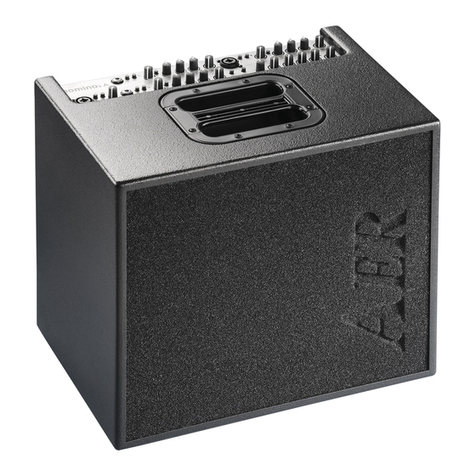
AER
AER Domino 2A User manual
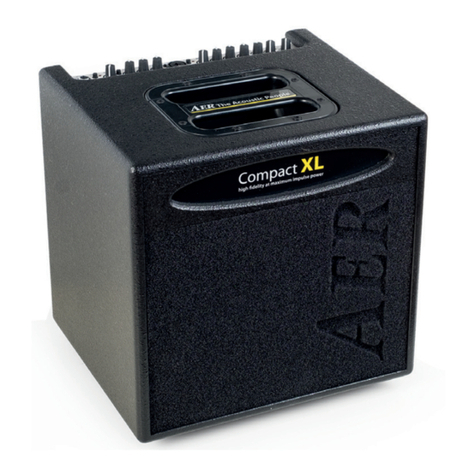
AER
AER Compact XL User manual
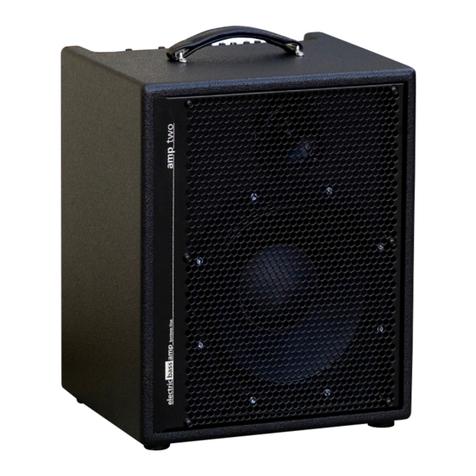
AER
AER Bottom Line Amp Two User manual

AER
AER Basscube User manual
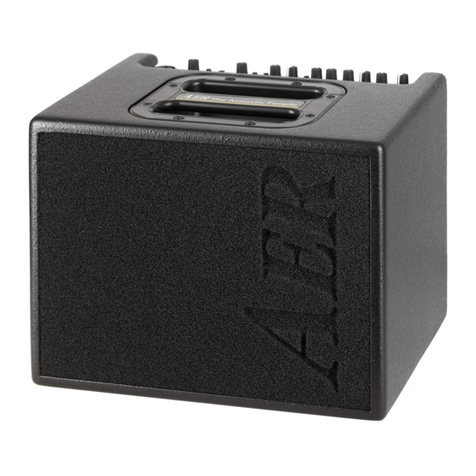
AER
AER Compact Classic pro User manual
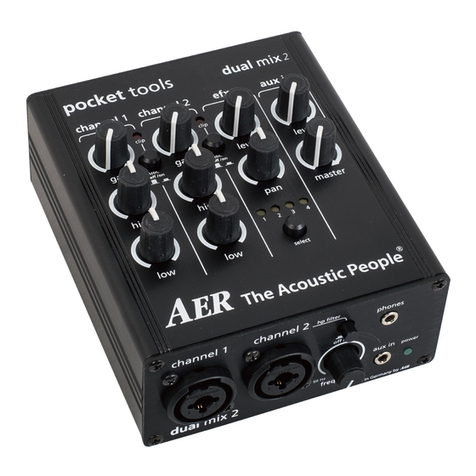
AER
AER Dual mix 2 User manual
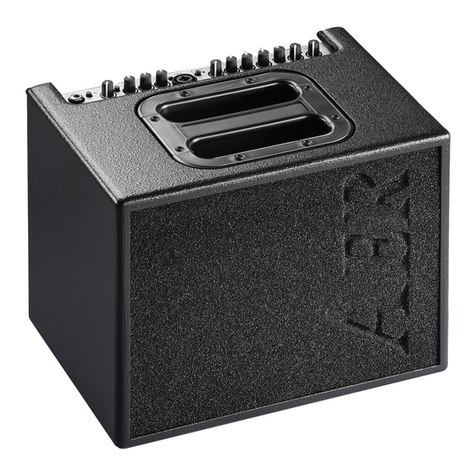
AER
AER Compact 60 3 User manual
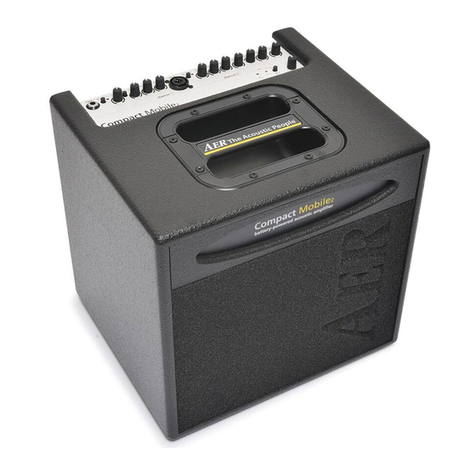
AER
AER COMPACT MOBILE 2 User manual

AER
AER Domino 2A User manual
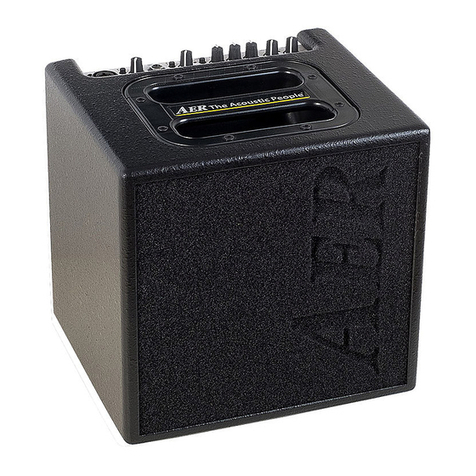
AER
AER Alpha User manual

AER
AER Domino 2A User manual
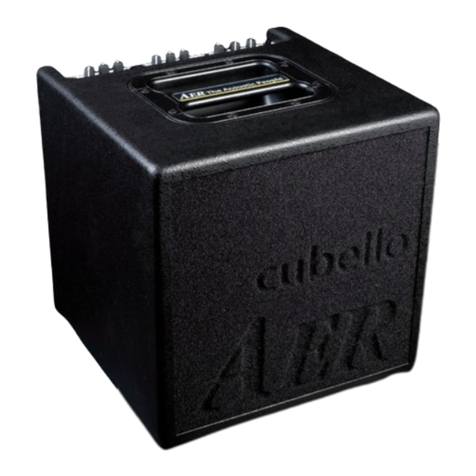
AER
AER Cubello User manual
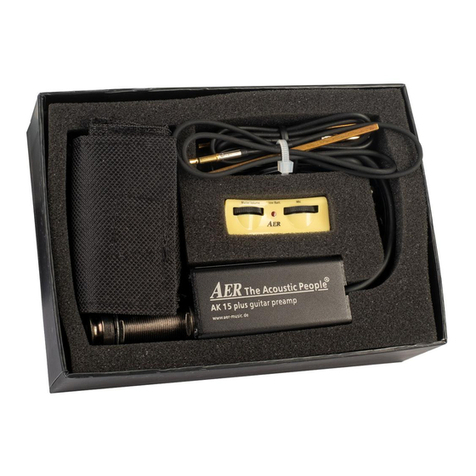
AER
AER AK15 plus User manual

AER
AER Compact 80 pro User manual
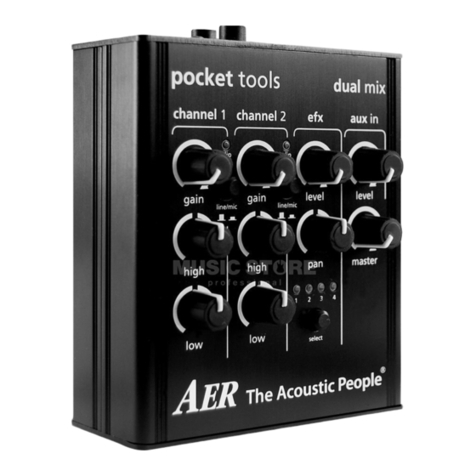
AER
AER pocket tools dual mix User manual

AER
AER The Acoustic People Compact 604 User manual
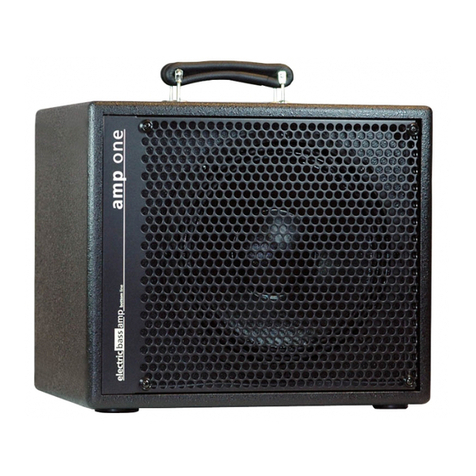
AER
AER amp one User manual
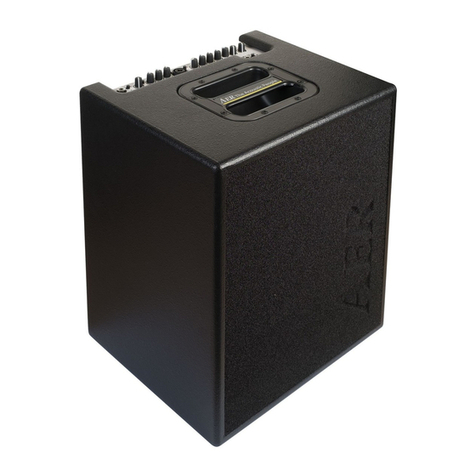
AER
AER MM 200 User manual
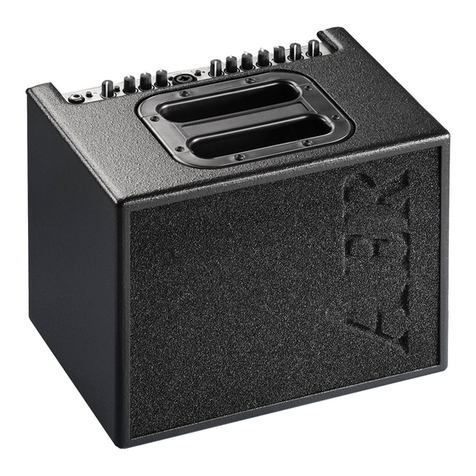
AER
AER Compact 603 User manual

AER
AER Compact mobile User manual

